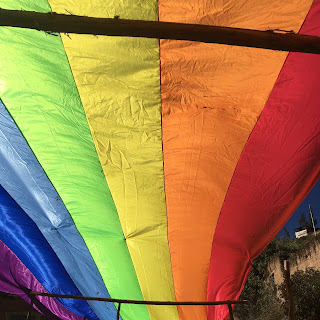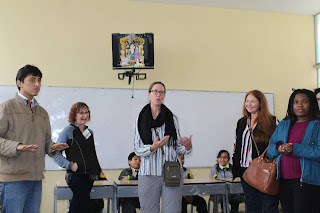When we first communicated with our host teacher, Clever, he asked us create some "science experiments" for his students. I definitely have no experience in developing science experiments, however, this entire Fulbright experience has been about stepping outside of my comfort zone, so I was happy to come up with something. My activity isn't really science based, but is more of a problem-solving, team-building activity. It involved Peruvian Cheerios (called Mel), string, and a few other items. The goal was to get the Cheerios onto the string without touching them with your hands (other items were ok) without speaking. The string would be held vertically when time was up and each team would get one point for each Cheerio that remained on the string. It was interesting to see how the students approached the problem. I did this activity at two different schools. The first group had very young students (equivalent of US first graders) all the way up to 11 year olds. The second group was older kids. The older kids enjoyed it so much they wanted to do it again, but the second time each team member could only use one hand. We had to up the ante since they'd already worked through it once. The older girls ended up picking up a piece of the cereal with their mouth while their partner put the string through the hole. The underlying message here is that by working together and using creativity to overcome obstacles, we can solve problems we face.
After all these activities with the students, some parents arrived with the principal to thank us for our time and efforts this week. It was a very nice and casual ceremony with an exchange of some gifts of appreciation. My partner and I were each asked to speak a few words and I found myself feeling surprisingly verklempt.
In the evening, about ten teachers arrived from within Tarma and neighboring towns for one final teacher workshop... On a Friday evening... After they had been teaching all week. Some even traveled more than 40 minutes one way. The dedication of these teachers is inspiring and touching. They want so badly to improve their own English skills and to help their students. English is a required subject in the nationalized curriculum, however, there are so few teachers who truly are proficient in English, that many times a teacher is assigned to be the English teacher even if he or she speaks little English. Such commitment and resolution are not unusual in this profession, but I have to say that I was so impressed that they were willing to give up their Friday evening. And not only for the teacher workshop, but they took us out for Chinese food afterward. The intention is to collaborate on future Internet-based projects to help improve English skills of both the teachers and the students. We had a great time at dinner, sharing dumb jokes and tongue twisters in both English and Spanish. But my favorite phrase of the evening, and you can relate if you've ever been in a big group that can't quite seem to get moving forward: calabasa, calabasa, todos a su casa! (Pumpkin, pumpkin, everyone home! - but way better in Spanish because it rhymes!)
Our final day in Tarma was full and valuable and reminded me of the many reasons why I love being part of this profession.


























































